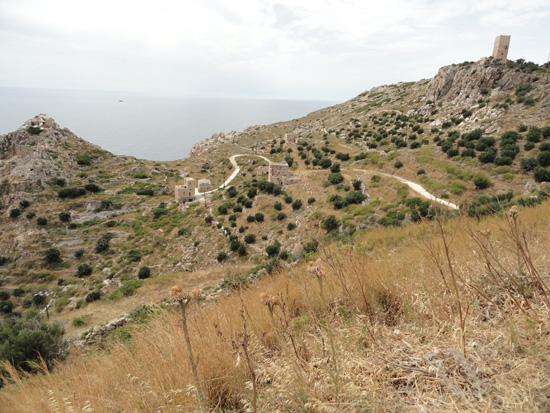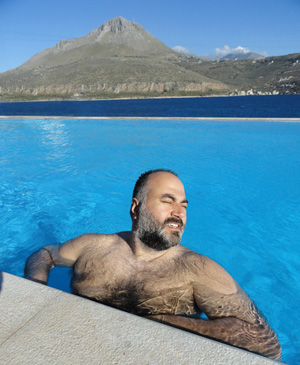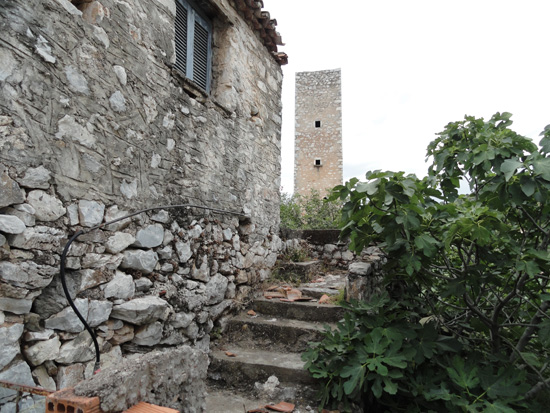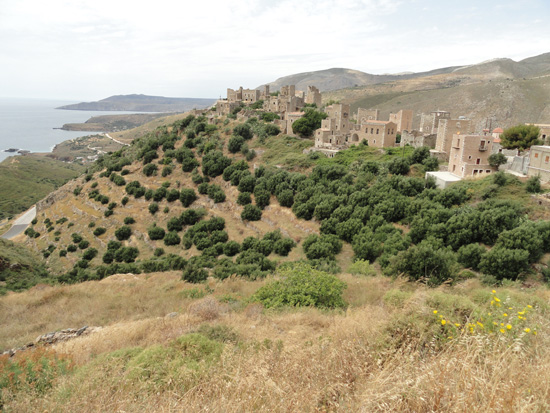
Stavros and I spent the weekend in the Mani, a small peninsula protruding from the southwest corner of the Peloponnesus. It’s a rugged area, rocky and mountainous. Once densely populated, now there are only about 5,000 year-round inhabitants. The architecture is all stone, mostly towers and castle-like structures, most long abandoned. There used to be “blood feuds” here, with one family attacking another until the defeated family gave up and accepted the conditions of the winning family. Hence a lot of bombed out towers. The Mani people were very independent, and embraced Christianity late, in the 9th century or so, and were even given autonomy during Ottoman rule. After the revolution against the Turks (which actually began in the Mani) the Mani-ites were unable to adjust to the new restrictions of the regime that they helped usher in and dispersed from the area, hence the dwindling population. Actually, the guy who started the revolution here ended up being imprisoned by the first president of Greece, and then his brothers took revenge and assassinated the president!
 We drove directly to Kalamata from Athens, and then slowly down the west coast road through Kardamyli to Neo Oitylo, on Limeni Bay. We stayed in the Afrodite (the goddess of love, beauty and pleasure!) Suite at the Selena Studios, a charming hotel with outstanding views overlooking the bay and the soft brown stone towers of the town of Limeni on the other side of the bay.
We drove directly to Kalamata from Athens, and then slowly down the west coast road through Kardamyli to Neo Oitylo, on Limeni Bay. We stayed in the Afrodite (the goddess of love, beauty and pleasure!) Suite at the Selena Studios, a charming hotel with outstanding views overlooking the bay and the soft brown stone towers of the town of Limeni on the other side of the bay.
The next day we wandered around the southern tip of the peninsula, starting in Areopolis, down the west coast road to Vathia. Vathia is a scenic hilltop village of crumbling stone towers overlooking the Messenian Gulf. Many of the towers were restored and a few seem to be inhabited, but a plan to restore the town as a tourist destination was abandoned in the 90s, and it now feels like a sort of stone ghost town, but with wildflowers blooming everywhere. After Vathia, we continued on to Porto Kagio for a delicious lunch on the pristine bay, then Point Tenero, and up the east Mani road to Lagia and Flomochori.

We took a different route back to Athens, via Gythio, tucked into the northeast corner of the Mani. There’s an ancient Roman theater there, which unfortunately I didn’t read about in my crappy guidebook and missed. Gythio was once the seaport of Sparta, but was destroyed in the 4th century A.D. It’s now the largest city in the Mani, with a charm quite different from the rest of the region: no stone towers and lots of people. We had a fantastic lunch of fried fish, marinated octopus, Greek salads and ouzo.

For our next trip, Stavros and I are off to Naxos, where Theseus abandoned Ariadne. Her fate wasn’t that bad: Dionysos swung by and married her. But then Perseus killed her. Or she hanged herself. Dionysos then descended into the underworld and brought her back, along with his mother (this is a Greek story) and they all settled down on Olympus. What adventure awaits us on Naxos??

Hi Chris !
Really enjoy reading your blog ! Have you ever heard of a writer named Patrick Leigh Fermor ? A very interesting British man who traveled all over Europe, settled in Greece and wrote some fascinating books. One is called: Mani: Travels in the Southern Peloponnese – check it out. So glad you are going on all these Greek adventures – love your photos !!!
Hi Diane, thanks so much for your comment! I haven’t read Fermor, but I will definitely check him out. I’ll be in Greece again at the end of September, looking forward to more adventures!